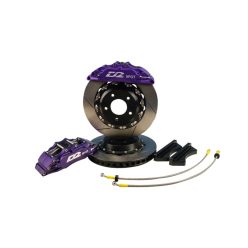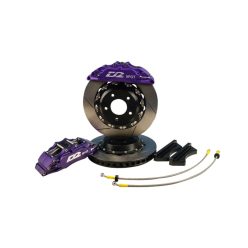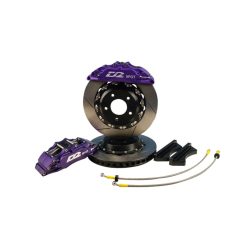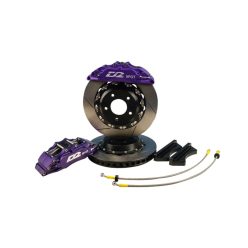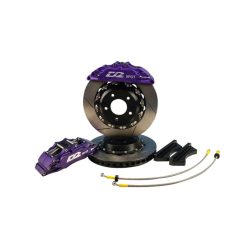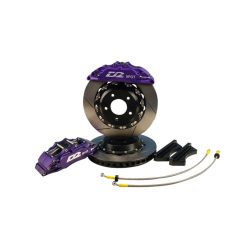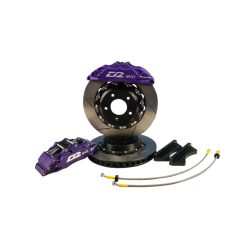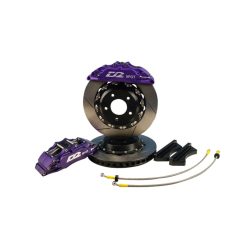Big Brake Kits deliver a complete front brake upgrade with larger ventilated brake discs, multi-piston calipers, braided lines and all required brackets. D2 Racing and Forge Motorsport BBK solutions with 4–6 piston forged monoblock calipers and 286–400 mm two-piece slotted or drilled rotors provide significantly higher thermal capacity, shorter stopping distances and a firmer, more consistent pedal feel for fast road, track day and drift applications.
Net price: 6 688 €
Net price: 1 946 €
Net price: 2 189 €
Net price: 2 386 €
Net price: 2 586 €
Net price: 2 716 €
Net price: 2 917 €
Net price: 2 432 €
Net price: 2 675 €
Net price: 2 675 €
Net price: 2 918 €
Net price: 3 648 €
Overview and Key Advantages
Big Brake Kits are designed to replace the factory front brakes with larger, more capable discs and multi-piston calipers. D2 Racing and Forge Motorsport kits typically combine 4- or 6-piston forged aluminium monoblock calipers with 2-piece, lightweight slotted or drilled rotors, greatly increasing heat capacity and reducing the risk of fade under repeated hard use. Beyond the raw stopping power, the main benefits are shorter stopping distances from high speeds, improved pedal feel and more consistent braking performance during long sessions or mountain descents.
Most big brake kits are supplied as complete packages including two front rotors with aluminium bells, left/right calipers, vehicle-specific brackets, stainless braided brake lines and pads matched to the intended use (Street, Sport or Racing). This allows you to swap out the OE front system as a whole while retaining compatibility with OEM parking brake solutions (drum-in-hat or electric handbrake) on the rear axle. Properly chosen, a BBK transforms braking confidence without compromising system integration.
Technical Basics
At the heart of a big brake kit is the multi-piston caliper. D2 Racing calipers are machined from aircraft-grade aluminium using a forged monoblock construction for low weight and high stiffness, improving pedal feel and limiting caliper deflection under extreme loads. The pistons are made from high temperature-resistant material and tested to around 1000 °C, while high-quality seals are designed to withstand road salt and other corrosive elements. This combination ensures durability as well as performance.
Rotor size and thickness—typically 286–400 mm in diameter and 28–32 mm thick—directly affect thermal capacity and mechanical leverage. A larger rotor radius generates more braking torque for the same line pressure, while increased thickness provides more material to absorb and dissipate heat. Slotted discs use machined grooves to continuously clean pad surfaces and evacuate gas and dust, whereas drilled discs rely on rows of holes to vent gas and aid cooling. Both designs aim to maintain pad contact and reduce fade, but slotted-only rotors are often preferred for intensive track use due to lower crack risk.
Supplied brake pads typically come in several compounds: Street pads for up to about 600 °C, Sport for sustained high temperatures and Racing compounds rated up to roughly 1000 °C. Matching pad friction characteristics and temperature range to your usage is just as important as choosing rotor size. Braided, Teflon-lined stainless brake hoses further improve pedal consistency by minimising hose expansion at high pressure, which is particularly noticeable during repeated hard stops on track.
Selection Criteria
When selecting a Big Brake Kit, start with your use case: fast road, frequent track days, time-attack or drift. For lighter cars and mainly road use, smaller rotor diameters in the 286–330 mm range with 4-piston calipers are often sufficient. Heavier, high-power cars or dedicated race/drift builds typically benefit from 356–380 mm rotors and 6-piston calipers to provide the necessary headroom. D2 Racing publishes minimum wheel size guidelines—for example 15" for 286 mm, 16" for 304 mm, 17" for 330 mm, 18" for 356 mm, 19" for 380 mm and 20" for 400 mm—so you must confirm that your wheels clear the calipers and bells.
Pad compound choice is equally critical. For dual-use street/track cars, a pad that works from cold but tolerates higher temperatures (Street or mild Sport) is usually best. Full race compounds deliver consistent friction at very high temperatures but may squeal, dust heavily and perform poorly when cold. You should also consider your brake fluid: high-quality DOT 4 or 5.1 fluid with a high dry and wet boiling point is essential to realise the benefits of a BBK, especially on long downhill sections or during extended sessions.
Finally, think about supporting modifications. Wider tyres, more aggressive compounds, revised suspension and wheel offset all influence how effectively the extra braking torque is used. If the chassis and tyres cannot exploit the added capability, the ABS may intervene early and the real-world stopping distance might not improve as much as expected. Ideally, a Big Brake Kit forms part of a balanced package that also considers suspension, tyres and brake bias.
Installation & Maintenance
Installing a BBK is a significant modification to the brake system, so professional installation is strongly recommended. Caliper brackets must be mounted to clean, flat hub surfaces and torqued correctly with a calibrated torque wrench. Rotor mounting faces should be free from rust and debris to minimise runout; excessive runout can lead to uneven pad deposits and Disc Thickness Variation (DTV), causing vibration and potentially voiding warranty if installation procedures were not followed.
When fitting braided lines, ensure all fittings are correctly seated and that hoses are routed away from moving components and heat sources. After plumbing the system, bench-bleed the master cylinder where possible and bleed the brakes in the recommended sequence until the pedal is firm. After the first heat cycles—such as a track day or spirited mountain drive—re-check all fasteners, inspect for leaks and visually examine rotors and pads for cracks, glazing or abnormal discolouration.
Long-term, a Big Brake Kit requires regular inspection. Rotor thickness should be measured periodically to ensure it does not fall below the minimum marked value, and pads should be replaced before backing plates are exposed. Proper pad bedding-in is crucial to avoid uneven transfer layers and to achieve consistent friction. Brake fluid should be changed at reasonable intervals, more frequently on heavily tracked cars, to maintain boiling point and protect the internals of calipers and master cylinders.
FAQ
How much will a Big Brake Kit improve my stopping distance?
The main benefit of a BBK is increased thermal capacity and consistency under repeated hard braking. Stopping distances can improve, especially from high speed, but the biggest gains are reduced fade, a firmer pedal and the ability to brake hard lap after lap without performance dropping off.
What wheel size do I need for a Big Brake Kit?
You must follow the kit manufacturer’s minimum wheel diameter chart—for example 17", 18", 19" or 20" depending on rotor size and caliper. In addition to diameter, spoke design and offset affect clearance, so always check caliper-to-spoke spacing and use spacers if needed.
Is a Big Brake Kit suitable for daily driving?
Yes, provided you choose appropriate pad compounds and rotor designs. For mixed street/track use, select Street or mild Sport pads that work well from cold and are not excessively noisy or dusty, while still benefiting from the BBK’s higher capacity on spirited drives or track days.
Do I need to change the master cylinder when fitting a BBK?
Many kits are engineered to work with the OEM master cylinder, but if total caliper piston area increases dramatically or the pedal feels excessively long and soft, an upgraded master may be advisable. A specialist can help calculate suitable bore sizes based on your calipers and pedal ratio.
What’s the difference between slotted and drilled rotors?
Slotted rotors use grooves to clean pad surfaces and vent gas with reduced crack risk, making them a strong choice for heavy track use. Drilled rotors offer good gas evacuation and an aggressive look but can be more prone to cracking under extreme conditions, so they are often preferred for performance street rather than pure racing.

